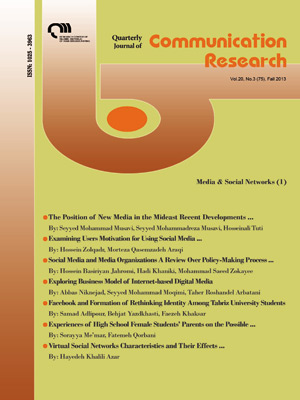برگر، کاتلین. ( 1389). روانشناسی رشد (ترجمه اسماعیل سعدیپور). تهران: دوران.
Bargh, J.A. (2002). Can You See the Real Me? Activation and Expression of the True Self' on the Internet. Journal of Social Issues, 58, pp. 33-48.
Beraman, P.S. & Moody, J. (2004). Adolescents Suicidability. American journal of public Health, 94, pp. 89-95.
Bimber, B. (2000). Measuring the Gender Gap in the Internet. Social Science Quarterly, 81, pp. 868-876.
Drori, G. (2006). Global E-Litism: Digital Technology, Social Inequality, and Transnationality. New York: Worth Publishers.
Economist. (2009).Primates on Facebook: Even Online, the Neo Cortex is the Limit. From:
http://www.economist.com/sciencetechnology/displaystory.cfm?story id =13176775 (accessed 26 June 2009).
Hill, R.A. & Dunbar, R.I.M. (2003). Social Network Size in Humans. Human Nature,Vol. 14, No.1, pp. 53-72.
Hine, C. (2005) . Internet Research and the Sociology of Cyber Social Scientific Knowledge. The Information Society, Vol. 21, pp. 239-248.
Larson, R.W. & Verma, S. (1999). How Children and Adolescents Spend Time Across the World: Work, Play, and Developmental Opportunities. Psychological Bulletin, 125, pp. 701-736.
Livingstone, S. & Bovill, M. (2001). Children and Their Changing Media Enviroment: A European Comparative Study. Hove, UK: Lawrence Erlbaum Associates Ltd.
Livingstone, S. & Helsper, E. (2007). Taking Risks When Communicating on the Internet. Information, Communication and Society,Vol. 5, pp. 619-644.
Marsden, P.V. & Campbell, K.E. (1984). Measuring Tie Strength. Social Forces, 63, pp. 482-501.
Mesch, G.S. & Talmud, I. (2007). Similarity and the Quality of Online and Offline Social Relationships Among Adolescents in Israel. Journal of Research in Adolescence, Vol.17, No.2, pp.455-465.
Neal, J.W. (2007). Why Social Networks Matter: A Structural Approach to the Study of Relational Aggression in Middle Childhood and Adolescence. Child and Youth Care Forum, 36, pp. 195-211.
Pfeil, U.; Arjan, R. & Panayiotis, Z. (2009). Differences in Online Social Networking - A Study of Users Profiles and the Social Capital Divide Among Teenagers and Older Users in Myspace. Computers in Human Behavior, 25, pp. 643-654.
Prensky, M. (2001). Digital natives, digital immigants. On the Horizen, Vol. 9, pp. 1-6.
Sassen, S. (2002). Toward a Sociology of Information Technology. Current Sociology, 50, pp. 365-388.
Subrahmanyam, K. & Greenfield, P. (2008). Online Communication and Adolescent Relationships. The Future of Children, Vol. 18, No. 1, pp. 119-146.
Turkle, S. (1996). Parallel Lives: Working on Identity in Virtual Spaces. In D.Grodin and T.R. Lindlof Constructing the Self in a Mediated World: Inquiries in Social Construction. Thousand Oaks, CA: Sage.
Van Dijk, J. (2005). The Deepening Divide: Inequality in the Information Society. London: Sage.
Wellman, B. & Gulia, M. (2001). Computer networks as social networks. Science, 293, 2031-2034.
Wellman, B.; Salaff, J.; Dimitrova, D.; Garton, L.; Gulia, M. & Haythornthwaite, C. (1996). Computer Networks as Social Networks. Annual Reviwe of Sociology, 22, pp. 213-238.
Wolak, J.; Mitchell, K.J. & Finkelhor, D. (2003). Escaping or Connecting? Characteristics of Youth Who Form Close Online Relationships. Journal of Adolescence, 26, pp. 105-119.
Youniss, J. & Smollar, J. (1996). Adolescents Interpersonal Relationships in Social Context. In T. Berndt and G.W. Ladd Peer Relationships in Child Development. New York: Wiley.

